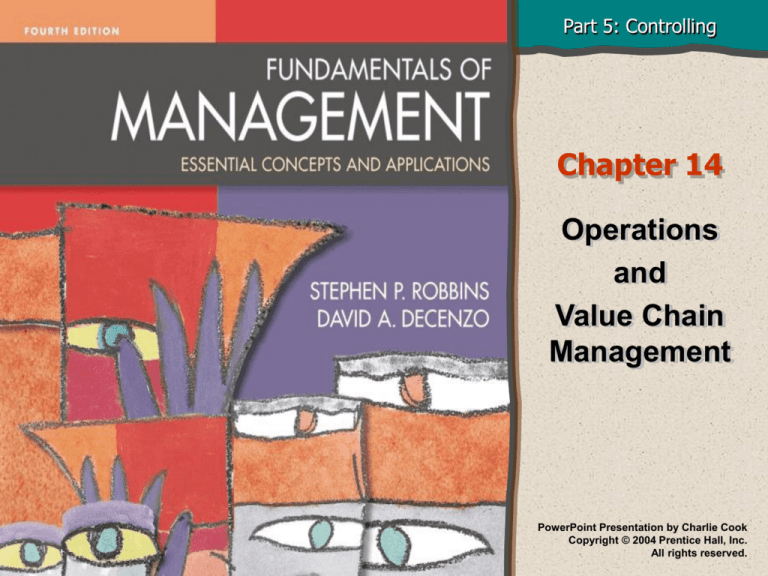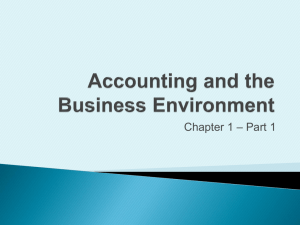
Part 5: Controlling
Chapter 14
Operations
and
Value Chain
Management
PowerPoint Presentation by Charlie Cook
Copyright © 2004 Prentice Hall, Inc.
All rights reserved.
LEARNING OUTCOMES
After reading this chapter, I will be able to:
1. Define operations management and the
transformation process.
2. Describe three reasons operations
management is important to all managers.
3. Differentiate between a service and a
manufacturing organization.
4. Define value chain management.
5. Explain the organizational and managerial
requirements for value chain management.
Copyright © 2004 Prentice Hall, Inc. All rights reserved.
14–2
L E A R N I N G O U T C O M E S (cont’d)
After reading this chapter, I will be able to:
6. Identify the benefits and obstacles to value
change management.
7. Discuss technology’s role in operations
management.
8. Explain what is meant by the term just-in-time
management.
9. Describe what is meant by the term quality
control.
10. Explain the concept of project management.
Copyright © 2004 Prentice Hall, Inc. All rights reserved.
14–3
The Importance Of Operations
Management
• Operations management defined
The study and application of the transformation
process
• OM is important because it:
Encompasses processes in all organizations—
services as well as manufacturing.
Is important in effectively and efficiently managing
productivity.
Plays a strategic role in an organization’s competitive
success.
Copyright © 2004 Prentice Hall, Inc. All rights reserved.
14–4
Transformation and Organizations
• Transformation process
The process through which an organization creates
value by turning inputs (people, capital, equipment,
materials) into outputs (goods or services)
• Manufacturing organization
Organizations that produce physical goods
• Service organization
An organization that produces nonphysical outputs
such as educational, medical or transportation
services
Copyright © 2004 Prentice Hall, Inc. All rights reserved.
14–5
The Transformation Process
EXHIBIT 14.1
Copyright © 2004 Prentice Hall, Inc. All rights reserved.
14–6
Productivity
• Productivity defined
The overall output of goods and services produced
divided by the inputs needed to generate that
output.
Outputs
Inputs
• Benefits of high productivity
Fosters economic growth and development
Increases individual wages without inflation
Lowers costs and makes firms more competitive
Copyright © 2004 Prentice Hall, Inc. All rights reserved.
14–7
Value and the Value Chain
• Value
The performance characteristics, features and
attributes, or any other aspects of goods and services
for which customers are willing to give up resources.
• Value chain
The entire series of organizational work activities that
add value at each step beginning with the processing
or raw materials and ending with a finished product in
the hands of end users.
Copyright © 2004 Prentice Hall, Inc. All rights reserved.
14–8
Value Chain Management versus Supply
Chain Management
• Value chain management
A method of improving the process of creating and
transferring documents by automating the flow of
information
• Supply chain management
Management of the facilities, functions, and activities
involved in producing and delivering a product or
service, from suppliers to customers.
Copyright © 2004 Prentice Hall, Inc. All rights reserved.
14–9
The Goals Of Value Chain Management
• Creating customer-defined value by:
Providing a unique combination that truly meets
customer needs and at a price that can’t be matched
by competitors.
Having a sequence of participants work together as a
team, each adding a component of value to the
overall process.
It’s all about providing value, not
bargains, to the customer
Copyright © 2004 Prentice Hall, Inc. All rights reserved.
14–10
Value Chain Management
• Business model
A strategic design for how a company intends to profit
from its broad array of strategies, processes, and
activities.
• Value chain management requirements
Coordination and collaboration
Technology investment
Organizational processes
Leadership
Employees/human resources management
Employees
Copyright © 2004 Prentice Hall, Inc. All rights reserved.
14–11
Six Requirements for Successful Value Chain
Management
EXHIBIT 14.2
Copyright © 2004 Prentice Hall, Inc. All rights reserved.
14–12
Effect of Value Chain Management on
Organizational Processes
• Better demand forecasting is necessary and
possible because of closer ties with customers
and suppliers.
• Selected functions may need to be done
collaboratively with partners in the value chain.
• New measures are needed for evaluating the
performance of activities along the value chain.
Copyright © 2004 Prentice Hall, Inc. All rights reserved.
14–13
Implementing Value Chain Management
• Benefits
Improved customer
service
Cost savings
Accelerated delivery
times
Improved quality
Inventory reduction
Improved logistics
management
Increased sales
Increased market share
Copyright © 2004 Prentice Hall, Inc. All rights reserved.
• Obstacles
Organizational barriers
Cultural attitudes
Required capabilities
People
14–14
Value Chain Benefits
Value chain survey respondents indicated the following are a “major
benefit” from sharing information with partners:
Percentage of
Companies in
Excellent or Very
Good Chains
Percentage of
Companies in
Poor
Chains
Percentage
of
All
Companies
Increased sales
41%
14%
26%
Cost savings
62%
22%
40%
Increased market share
32%
12%
20%
Inventory reductions
51%
18%
35%
Improved quality
60%
28%
39%
Accelerated delivery times
54%
27%
40%
Improved logistics management
43%
15%
27%
Improved customer service
66%
22%
44%
Source: G. Taninecz, “Forging the Chain,” Industry Week, May 15, 2000, p.44.
Copyright © 2004 Prentice Hall, Inc. All rights reserved.
EXHIBIT 14.3
14–15
Obstacles to Successful Value Chain
Management
EXHIBIT 14.4
Copyright © 2004 Prentice Hall, Inc. All rights reserved.
14–16
Contemporary Operations Management
Issues
• Technology
How an organization will transform its inputs into
outputs.
• Just-in-time (JIT) inventory systems
How to develop systems in which inventory items
arrive when needed in the production process instead
of being stored in stock.
• Continuous improvement and quality control
How to ensure that what is currently produced meets
preestablished standards.
Copyright © 2004 Prentice Hall, Inc. All rights reserved.
14–17
Quality and Operations Management
• Quality control
Monitoring quality—weight, strength, consistency,
color, taste, reliability, finish, or any one of myriad
characteristics—to ensure that it meets some
preestablished standard.
• Continuous improvement
A comprehensive, customer-focused program to
continuously improve the quality of the organization’s
processes, products and services.
Copyright © 2004 Prentice Hall, Inc. All rights reserved.
14–18
Managing Projects
• Project
One-time-only set of activities with a definite
beginning and ending point in time
• Project management
Task of getting the activities done on time, within
budget, and according to specifications
Copyright © 2004 Prentice Hall, Inc. All rights reserved.
14–19
Popular Scheduling Tools
• Gantt chart
A planning tool that shows in bar graph form when
tasks are supposed to be done and compares that
with the actual progress on each task.
• Load chart
As modified version of a Gantt Chart, the load chart
lists either whole departments or specific resources.
This
information allows managers to plan and control
for capacity utilization in the scheduling of individual
work stations.
Copyright © 2004 Prentice Hall, Inc. All rights reserved.
14–20
A Sample Gantt Chart
EXHIBIT 14.5
Copyright © 2004 Prentice Hall, Inc. All rights reserved.
14–21
A Sample Load Chart
EXHIBIT 14.6
Copyright © 2004 Prentice Hall, Inc. All rights reserved.
14–22
PERT
• Program evaluation and review technique
(PERT) network analysis
A flowchart-like diagram that depicts the sequence of
activities needed to complete a project and the time
or costs associated with each activity
Copyright © 2004 Prentice Hall, Inc. All rights reserved.
14–23
PERT Components
• Events
End points that represent the completion of major activities
• Activities
Actions that take place
• Slack time
The time difference between the critical path and all other
paths
• Critical path
The longest or most time-consuming sequence of events
and activities required to complete a project in the shortest
amount of time
Copyright © 2004 Prentice Hall, Inc. All rights reserved.
14–24
Developing PERT Charts
• Identify every significant activity that must be
achieved for a project to be completed.
• Ascertain the precedence order in which these
events must be completed and create a diagram
reflecting the ordering of activities.
• Compute a weighted average time estimate
(expected time) for completing each activity.
• Insert start and finish times into the diagram and
inspect to determine the critical path.
EXHIBIT 14.7
Copyright © 2004 Prentice Hall, Inc. All rights reserved.
14–25
Major Activities in Building a Custom Home
TIME
(WEEKS)
PREDECESSOR
ACTIVITY
EVENT
DESCRPTION
A
Approve design and get permits
3
None
B
Perform excavation/lot clearing
1
A
C
Pour footers
1
B
D
Erect foundation walls
2
C
E
Frame house
4
D
F
Install windows
0.5
E
G
Shingle roof
0.5
E
H
Install brick front and siding
4
F,G
I
Install electrical, plumbing, and
heating and A/C rough-ins
6
E
J
Install insulation
0.25
I
K
Install sheetrock
2
J
L
Finish and sand sheetrock
7
K
M
Install interior trim
2
L
N
Paint house (interior and exterior)
2
H, M
O
Install all cabinets
0.5
N
P
Install flooring
1
N
Q
Final touch-up and turn over
house to homeowner
1
O, P
Copyright © 2004 Prentice Hall, Inc. All rights reserved.
EXHIBIT 14.8
14–26
A PERT Network for Building a Custom Home
Critical Path
EXHIBIT 14.9
Copyright © 2004 Prentice Hall, Inc. All rights reserved.
14–27








